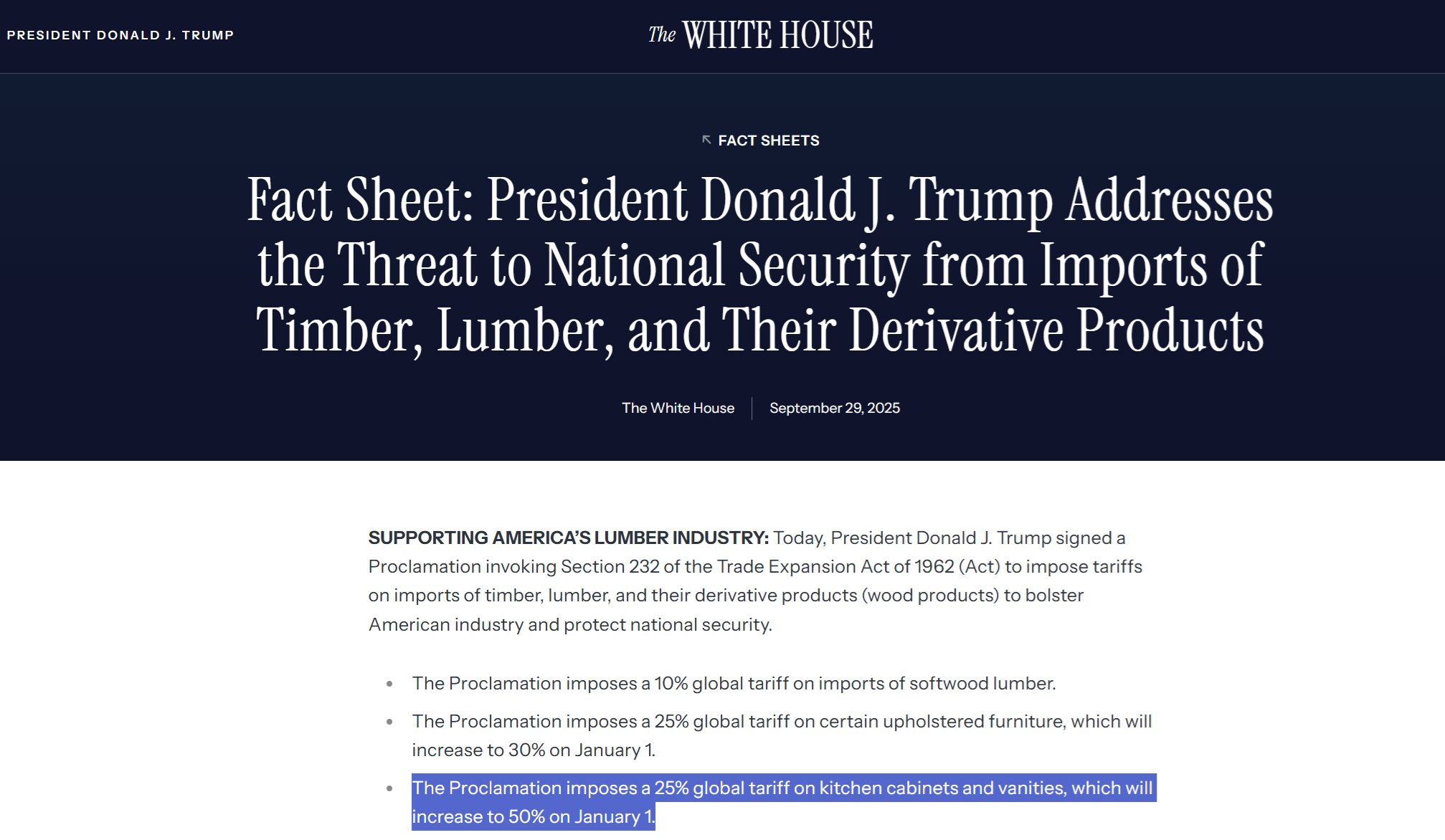Trump’s New Tariffs Shake the RTA Cabinet Industry: What Importers Need to Know
On September 30, 2025, the Trump administration announced a policy that sent shockwaves through the RTA cabinet industry. Beginning October 14, 2025, cabinet products under HS codes 9403.40 and 9403.91 will face an additional 25% tariff, on top of existing duties. Starting January 1, 2026, the tariff rate will rise to 50%, also cumulative with prior duties.
The Proclamation imposes a 25% global tariff on kitchen cabinets and vanities, which will increase to 50% on January 1.
For U.S. importers sourcing from Southeast Asia, particularly Vietnam, this is a heavy blow. Cabinets from Vietnam already face a 20% countervailing duty. Once the new measures take effect, the effective duty rate could climb to 70%—a staggering increase that will inevitably push up costs in the U.S. market.
Short-Term Reactions from Importers
The immediate response has been predictable: importers are rushing to ship as much inventory as possible before the end of November, ensuring containers arrive at U.S. ports before January 1, 2026. While this “beat the deadline” strategy may help in the short run, it only delays the inevitable. Once current inventory is sold through, the true cost of RTA cabinets in the U.S. will rise sharply.
Potential Strategies for Importers
Industry players are now debating how to adapt. Several strategies are being explored, each with its pros and cons:
Sourcing Carcasses Domestically, Importing 3-Set Doors/Fronts
By producing cabinet carcasses in the U.S. and only importing doors, drawer fronts, and face frames, importers can reduce taxable import value. However, U.S. manufacturing efficiency and costs may not be competitive enough to offset a 50% tariff.Undervaluing Imports (DDT Approach)
Some may consider underreporting declared customs values to save on duties. While this exploits a loophole, it is extremely risky. Large discrepancies are likely to trigger U.S. Customs audits, leading to back payments, fines, and even criminal liability.Third-Country Trading Companies
Setting up a trade entity in a neutral jurisdiction to issue three-way contracts could potentially lower tariff exposure. Yet, this approach is complex, costly, and may still attract scrutiny from U.S. Customs.Shifting Production to Eastern Europe
Moving cabinet production to countries with favorable trade relations could be a longer-term solution. Currently, U.S. tariffs on EU-made cabinets are capped at 15%, and Section 232 duties on cabinets may not apply. However, this option requires further verification and substantial investment in new supply chains.
Long-Term Market Implications
The Trump administration’s objective is clear: protect and revive U.S. cabinet manufacturing. In the medium to long term, more cabinet component production may shift back to the U.S., especially in areas where automation reduces labor costs. While this could support domestic jobs, it will also drive up procurement costs, fuel inflation in the remodeling sector, and potentially dampen demand among homeowners and multi-family developers.
Key Takeaway for Multi-Family Builders and Importers
The new tariff structure will fundamentally reshape the RTA cabinet supply chain. Importers and multi-family builders must prepare for rising costs, tighter margins, and supply chain restructuring. Whether through partial reshoring, strategic sourcing diversification, or negotiating new supplier agreements, adapting quickly will be essential to remain competitive in 2026 and beyond.


